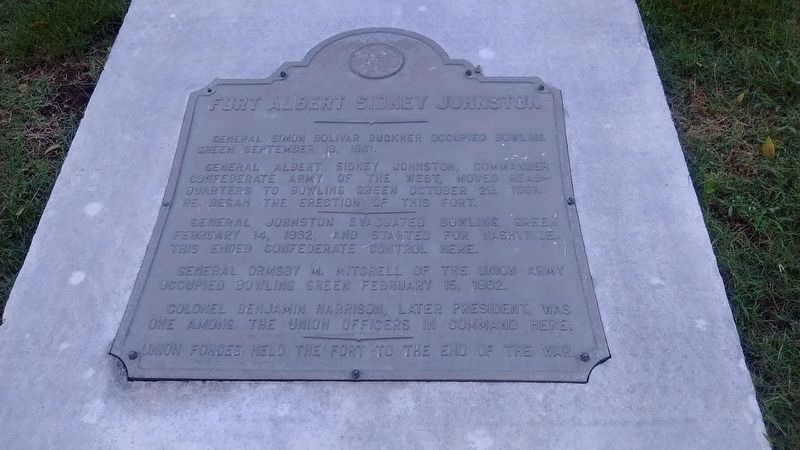Fort Albert Sydney Johnston; Marker memorializing a Confederate fort
Item
- Legacies Classification
- Memorial Type
- Memorial Context
- Memorialized Subject
- Title
- Background and Context
- Physical Description
- Memorial Inscription
- Date created, installed or dedicated
- Historical Period
- Funded by
- Location: Institution, City, State
- Learn More About this Subject
-
Memorial Artwork
-
Plaque/Marker
-
Johnston, Albert Sydney
-
Fort Albert Sydney Johnston; Marker memorializing a Confederate fort
-
Confederates first began construction of the Old Fort in 1861 at the top of Vinegar Hill in Bowling Green, KY. They abandoned it six months later and federal forces held the city for the rest of the war. The Union Army completed construction of the Vinegar Hill site, with most of the work done by the 12th Regiment, Heavy Artillery, United States Colored Troops. Initially labelled Fort Vinegar, the installation was later named for General William Haines Lytle, a United States Army officer and celebrated poet who was killed at the Battle of Chickamauga in 1863. This site was later purchased for the construction of Potter College for Young Ladies and Western Kentucky State Normal School. President Henry Hardin Cherry’s plans to destroy the fort to construct a library alarmed Arndt M. Stickles, a close friend of Cherry and long-time head of the History Department. Stickles convinced him of the fort’s value and persuaded him to move the proposed library further down the hillside. Cherry suggested an informational plaque for the site and Stickles wrote the text. Likely influenced by the Lost Cause mystique and the Confederate sympathies prevalent in southcentral Kentucky in the 1920s, Stickles consistently referred to the installation as a Confederate fort. He and Cherry decided to call the installation Fort Albert Sidney Johnston to honor a prominent enslaver and commander of Confederate troops in the west. Stickles built a neo-Confederate narrative around the fort that ignored the role of Black United States troops in constructing it as well as its official name of General Lytle. During the Lost Cause era, flag raising ceremonies were held at the Old Fort and attended by university administrators, students, and the public. (Written with major contributions from Historian David Lee)
-
The Old Fort
Confederate forces arrived in Bowling Green in September, 1861, and the town was designated as the capital of Confederate Kentucky even though the commonwealth never seceded. Rebel troops promptly set about fortifying the city, and as part of this effort, they began work on a fort-like structure at the top of Vinegar Hill. They abandoned the city six months later, however, and United States forces held Bowling Green for the rest of the war. The Union Army completed construction of the Vinegar Hill site, with most of the work done by the 12th Regiment, Heavy Artillery, United States Colored Troops. Initially labelled Fort Vinegar, the installation was later named for General William Haines Lytle, a United States Army officer and celebrated poet who was killed at the Battle of Chickamauga in 1863.
The fort still stood at the top of Vinegar Hill when first Potter College and then Western Kentucky State Normal School arrived on the hilltop. To make room for new construction that was shaping the campus in the 1920s, Cherry planned to destroy the fort to make way for a much-needed library building. Cherry’s intentions alarmed Arndt M. Stickles, a close friend of Cherry and the long-time head of the Department of History. Stickles shared his research on the location with Cherry, convincing him of the fort’s value and persuading him to move the proposed library a little further down on the hillside in order to preserve the remnants of the fort. Cherry suggested an informational plague for the site, and Stickles wrote the text. Likely influenced by the Lost Cause mystique and the Confederate sympathies prevalent in southcentral Kentucky in the 1920s, Stickles consistently referred to the installation as a Confederate fort, and he and Cherry decided to call the installation Fort Albert Sidney Johnson to honor the commander of Confederate troops in the west. Although the fort was only briefly in Confederate hands and there is no evidence that Johnson’s name was ever attached to the fort by the Confederates themselves, Stickles built a neo-Confederate narrative around the fort that ignored the role of Black United States troops in constructing it as well as the name of General Lytle for whom the United States Army named the fort.
-
The metal marker is approximately four feet in height and three feet in width. It has raised letters and is mounted on a limestone slab donated by Rhea Price. The state seal of Kentucky is located at the top of the marker.
-
General Simon Bolivar Buckner occupied Bowling Green September 18, 1861.
General Albert Sidney Johnston, Commander Confederate Army of the West, move headquarters to Bowling Green October 28, 1861. He began the erection of this fort.
General Johnston evacuated Bowling Green February 14, 1862, and started for Nashville. This ended Confederate control here.
General Ormsby M. Mitchell of the Union Army occupied Bowling Green February 15, 1862.
Colonel Benjamin Harrison, later President, was one among the Union officers in command here.
Union forces held the fort to the end of the war.
-
November 1931
-
Arendt Stickles
-
President Henry Hardin Cherry
Position: 877 (7 views)
